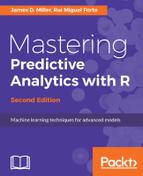Predictive analytics incorporates a variety of statistical techniques from predictive modeling, machine learning, and data mining that aim to analyze current and historical facts to produce results referred to as predictions about the future or otherwise unknown events.
R is an open source programming language that is widely used among statisticians and data miners for predictive modeling and data mining. With its constantly growing community and plethora of packages, R offers the functionality to deal with a truly vast array of problems.
This book builds upon its first edition, meaning to be both a guide and a reference to the reader wanting to move beyond the basics of predictive modeling. The book begins with a dedicated chapter on the language of models as well as the predictive modeling process. Each subsequent chapter tackles a particular type of model, such as neural networks, and focuses on the three important questions of how the model works, how to use R to train it, and how to measure and assess its performance using real-world datasets.
This second edition provides up-to-date in-depth information on topics such as Performance Metrics and Learning Curves, Polynomial Regression, Poisson and Negative Binomial Regression, back-propagation, Radial Basis Function Networks, and more. A chapter has also been added that focuses on working with very large datasets. By the end of this book, you will have explored and tested the most popular modeling techniques in use on real-world datasets and mastered a diverse range of techniques in predictive analytics.
Chapter 1, Gearing Up for Predictive Modeling, helps you set up and get ready to start looking at individual models and case studies, then describes the process of predictive modeling in a series of steps, and introduces several fundamental distinctions.
Chapter 2, Tidying Data and Measuring Performance, covers performance metrics, learning curves, and a process for tidying data.
Chapter 3, Linear Regression, explains the classic starting point for predictive modeling; it starts from the simplest single variable model and moves on to multiple regression, over-fitting, regularization, and describes regularized extensions of linear regression.
Chapter 4, Generalized Linear Models, follows on from linear regression, and in this chapter, introduces logistic regression as a form of binary classification, extends this to multinomial logistic regression, and uses these as a platform to present the concepts of sensitivity and specificity.
Chapter 5, Neural Networks, explains that the model of logistic regression can be seen as a single layer perceptron. This chapter discusses neural networks as an extension of this idea, along with their origins and explores their power.
Chapter 6, Support Vector Machines, covers a method of transforming data into a different space using a kernel function and as an attempt to find a decision line that maximizes the margin between the classes.
Chapter 7, Tree-Based Methods, presents various tree-based methods that are popularly used, such as decision trees and the famous C5.0 algorithm. Regression trees are also covered, as well as random forests, making the link with the previous chapter on bagging. Cross validation methods for evaluating predictors are presented in the context of these tree-based methods.
Chapter 8, Dimensionality Reduction, covers PCA, ICA, Factor analysis, and Non-negative Matrix factorization.
Chapter 9, Ensemble Methods, discusses methods for combining either many predictors, or multiple trained versions of the same predictor. This chapter introduces the important notions of bagging and boosting and how to use the AdaBoost algorithm to improve performance on one of the previously analyzed datasets using a single classifier.
Chapter 10, Probabilistic Graphical Models, introduces the Naive Bayes classifier as the simplest graphical model following a discussion of conditional probability and Bayes' rule. The Naive Bayes classifier is showcased in the context of sentiment analysis. Hidden Markov Models are also introduced and demonstrated through the task of next word prediction.
Chapter 11, Topic Modeling, provides step-by-step instructions for making predictions on topic models. It will also demonstrate methods of dimensionality reduction to summarize and simplify the data.
Chapter 12, Recommendation Systems, explores different approaches to building recommender systems in R, using nearest neighbor approaches, clustering, and algorithms such as collaborative filtering.
Chapter 13, Scaling Up, explains working with very large datasets, including some worked examples of how to train some models we've seen so far with very large datasets.
Chapter 14, Deep Learning, tackles the really important topic of deep learning using examples such as word embedding and recurrent neural networks (RNNs).
